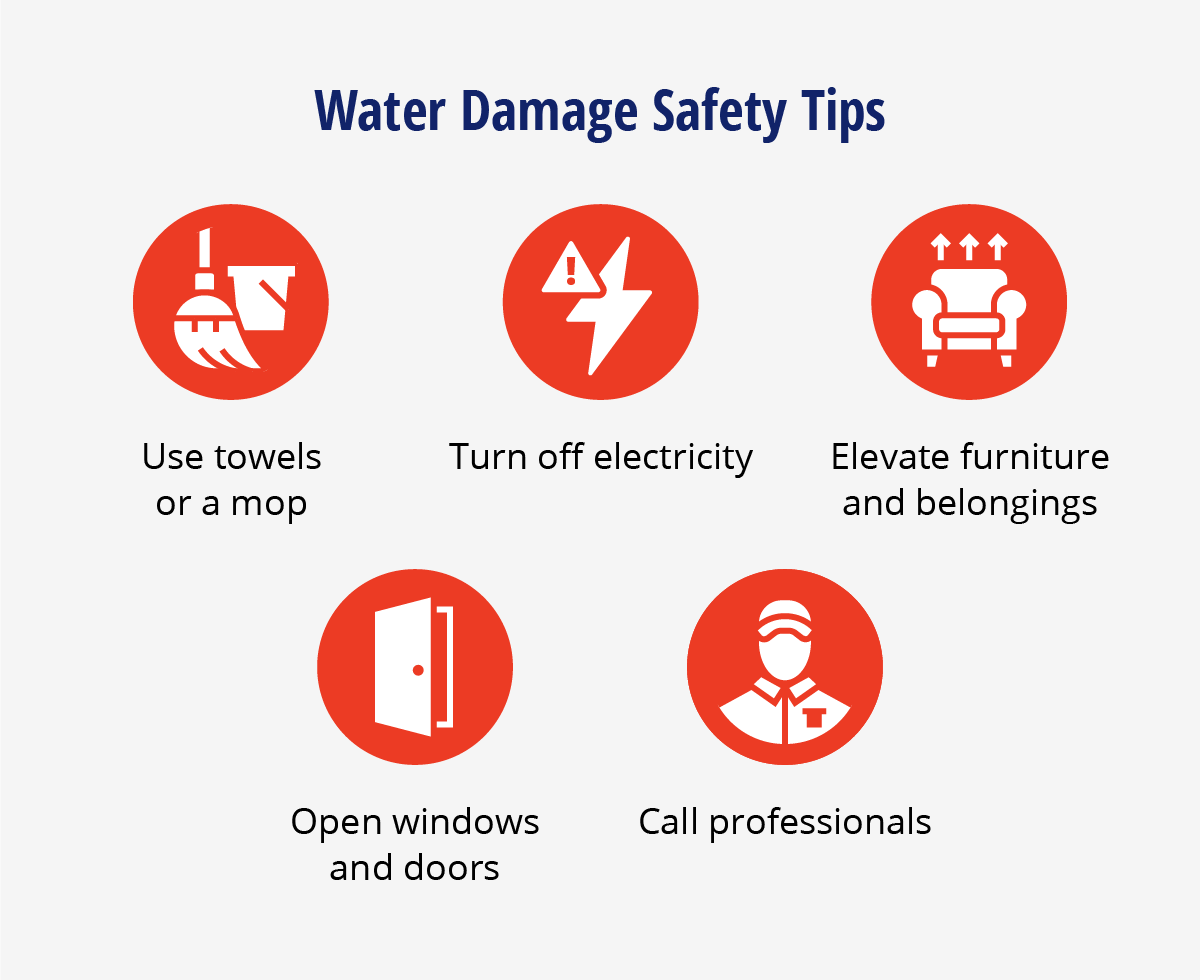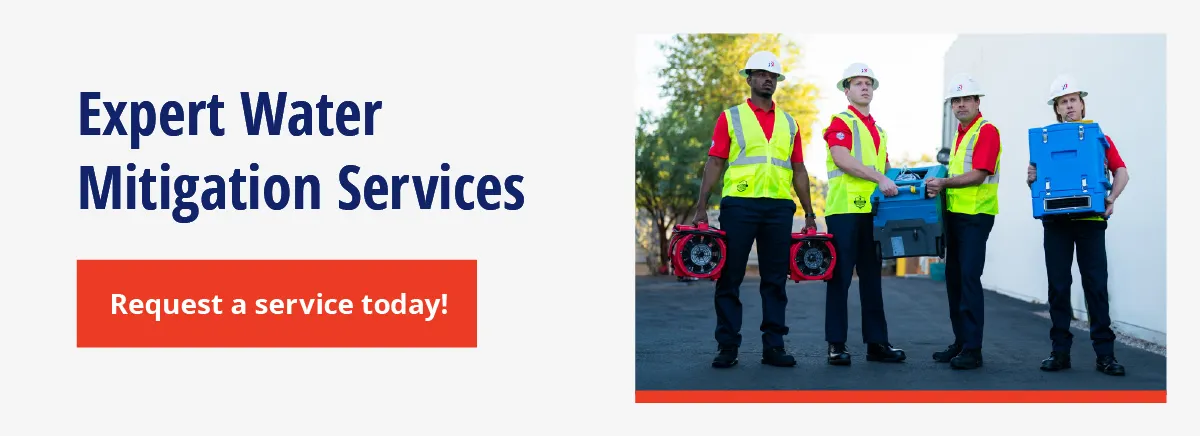.webp)
Water mitigation is the process of minimizing the initial damage caused by water intrusion or flooding in a property. Water damage restoration, on the other hand, is a more comprehensive process involving repairing and restoring or even reconstructing the property to its best possible condition.
From burst pipes to natural disasters, water damage is a common threat that can wreak havoc on a property and lead to costly repairs and health hazards such as mold. Professional water mitigation can help curb the effects of water damage and provide immediate remediation to the affected areas.
Read on to understand what water mitigation is and learn its importance in protecting property and health, along with practical tips for addressing water damage effectively.
What Is Water Mitigation?
Water mitigation is the process of minimizing water damage after a disaster. It includes steps like water extraction and drying the affected area to prevent further damage immediately following a flood or leak. Remediation professionals perform water mitigation to restore affected areas to their best possible condition to prevent the long-term damage that can be caused by standing water.
Professional water mitigation experts have the knowledge, skills, and equipment necessary for thorough mitigation. Proper water mitigation not only helps minimize damage but also results in significant cost savings by preventing further deterioration and the need for extensive repairs.
What Is Water Damage Restoration?
Water damage restoration is the comprehensive process of mitigating and repairing damage caused by water intrusion. It aims to restore affected properties to their best possible condition.
Water damage restoration involves using dehumidifiers to reduce moisture and air movers to facilitate the drying process and improve conditions in the affected area. Depending on the initial damage, this process can take from a few days up to a week or more — service professionals will keep an eye on existing conditions and make any necessary adjustments.
Rainbow Restoration® prioritizes the health and safety of occupants when conducting water damage restoration. The water damage restoration process begins by assessing potential hazards, and implementing necessary precautions before any restoration work begins. Service professionals then assess the extent of the damage and make a restoration plan.
Request a water damage restoration appointment today.
Water Mitigation vs. Water Damage Restoration
While water mitigation and water damage restoration are two different processes, they are often used interchangeably. Here are the distinct differences between the two:
Water mitigation is preventative. It focuses on immediate concerns after a water incident, such as stopping leaks and removing excess water. This process typically involves rapid water extraction, moisture detection, structural drying, mold prevention measures, and temporary repairs.
Water restoration is reactive. It involves a more comprehensive approach to fully repair and restore the affected area to its best possible condition after water damage has already occurred. Key activities include comprehensive damage assessment, structural repairs, contents restoration, dehumidification, and stabilizing the environment.
| Water Mitigation | Water Damage Restoration |
|---|---|
| Immediate response after water damage occurs | Begins after mitigation and focuses on full restoration |
| Minimizes water damage and prevents further harm | Restores property to the best possible condition |
| Focuses on initial cleanup and damage prevention | Comprehensive restoration of property and belongings |
| Water extraction, drying, and moisture control | Structural repairs and contents restoration |
| Short-term process; typically lasting a few days | Long-term process; duration varies based on the extent of damage |
Water Mitigation Process
In the water mitigation process, professionals take immediate steps to minimize and contain the initial damage caused by water intrusion or flooding. Attempting these steps without professional help poses risks such as exposure to harmful contaminants and ineffective restoration. Here's an overview of the key steps professionals take:
- Health and safety precautions: This initial step prioritizes safety measures to protect both occupants and restoration professionals from potential hazards. It includes identifying and mitigating risks associated with electrical issues, structural damage, and potential exposure to harmful substances.
- Damage assessment and inspection: A detailed assessment then determines the class and category of damage. This information forms the basis for developing a restoration plan tailored to the nature of the damage.
- Contents protection: Service professionals will ensure that valuables and belongings are safeguarded from further damage during the restoration process. This involves careful removal, assessment, and appropriate protective measures to ensure their preservation.
- Remove water physically: Mitigation specialists use equipment such as pumps and extractors to remove standing water and excess moisture from the affected area. This step prevents further damage and fosters a conducive environment for restoration.
- Clean and sanitize: Professionals thoroughly clean and disinfect surfaces to eliminate potential health hazards. This includes addressing issues such as mold growth and the spread of contaminants to ensure a safe environment.
- Provide necessary equipment: Professionals then deploy drying equipment — such as dehumidifiers and air movers — to facilitate the drying process. Proper equipment placement is essential for achieving optimal results in restoring materials to their best possible condition.
- Create ideal drying conditions: Professionals meticulously control temperature, humidity levels, and airflow using equipment such as dehumidifiers to promote the efficient drying of materials. This step is vital for preventing long-term damage and ensuring a successful restoration outcome.
- Monitor daily: Lastly, regular assessments are conducted to track progress and make necessary adjustments to the restoration plan. This ongoing monitoring ensures the restoration efforts are effective and allows for timely interventions to address any issues.
Rainbow Restoration service professionals are fully certified by the Institute of Inspection Cleaning and Restoration Certification (IICRC). Restoration teams take an aggressive approach to mitigation to minimize losses and downtime.
.webp)
Water Damage Mitigation and Safety Tips
When dealing with a flood or other water-related emergencies, it is important to take immediate action to prevent further harm and ensure the safety of occupants. Here are some essential tips to follow and steps to take before professionals arrive:
- Turn off electricity in the affected area and avoid using electrical appliances in wet areas to prevent accidents.
- Use towels or a mop to soak up excess water from affected areas.
- Place aluminum foil or wooden blocks under furniture legs to prevent water absorption.
- Elevate furniture and belongings (if possible) off wet floors to minimize damage.
- Remove valuable items and documents from water-exposed areas to prevent further damage.
- Avoid walking on wet carpets to prevent spreading water to unaffected areas.
- Keep pets and children away from water-damaged areas for safety.

Tips for staying safe when flooding or other water damage occurs include:
- Do not use a vacuum cleaner to suck up water, as it poses an electrocution hazard.
- Avoid wading through floodwaters, especially if they are fast-moving or deep.
- Be cautious of hidden hazards such as sharp objects or debris in flooded areas.
- Do not enter flooded basements or crawl spaces until they have been properly inspected for safety.
- Use a flashlight instead of candles or open flames to avoid fire hazards in flooded areas.
- Seek professional help for thorough cleanup and restoration to ensure safety and proper mitigation of water damage.
Professional Water Damage Restoration Services
Storms, leaky appliances, and even fire suppression efforts can cause water damage to a property and its contents. Rainbow Restoration works with insurance professionals, property managers, and property owners to deliver efficient, loss-minimizing services that help occupants return to normalcy.
This article is intended for general informational purposes only and may not be applicable to every situation. You are responsible for determining the proper course of action for your property. Services should be performed by licensed and experienced professionals. Rainbow Restoration is not responsible for any damages that occur as a result of this blog content or your actions. For the most accurate guidance, contact a Rainbow Restoration professional for a custom, on-site assessment.

